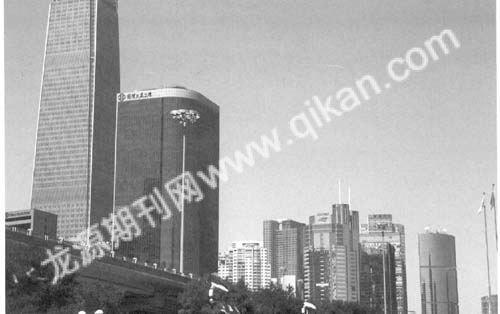Will China’s Economy Bottom out?
2009-08-22
Bottom out or not? The discussion about Chinas current macroeconomic situation gets heated at this moment. Both sides have their own reasons and proofs which sound reasonable.
There are optimistic and pessimistic sides. The organizations and analysts holding optimistic opinions think that Chinas economy has hit the bottom or will bottom out. The macroeconomic situation is going to take a favorable turn. However, the pessimistic thought is that the economy can not be said to hit the bottom based on the short-term data. The Development Research Center of the State Council (DRC), the Chinese Academy of Social Science (CASS), the State Information Center (SIC) and some other institutions all submitted their own reports about the economic performance of this year to the State Council. However, the results they gained were different. Even the DRC had two different kinds of ideas inside it.

Will Chinas economy see a V-shape rebound, a W-shape rebound, a U-shape rebound or even an L-shape rebound? People have been discussing about this for several straight months. Ironically, the reports of different organizations were based on the same data, but the results were different. Thus, what is the status quo of Chinas economy?
Beautiful Data
At the end of 2008, the central government of China made a large amount of investments in the infrastructure facilities and achieved good results. The economic performance of China in the first quarter was better than expected.
On May 11, the National Bureau of Statistics (NBS) published the statistical data, showing that the Consumer Price Index (CPI) fell by 1.5% in April compared with March and the Production Price Index (PPI) fell by 6.6%.
Chinas CPI and PPI have seen negative growth for three straight months since this February. Many experts said that the fall of PPI and CPI were not beyond expectation. A series of data shows that Chinas economy has taken on a positive trend despite those uncertainties.
April was the sixth straight month in which Chinas export saw a decrease. However, the export in April was better than March, up by 10.4%. This month-on-month increase may not mean the change to the shrink of the foreign demand, but at least it means that the decrease rate is smaller.

Song Guoqing, a professor of economics in Beijing University, said that the integrated macro economy of China is rallying and its foundation is quite solid. The obvious month-on-month increase of the CPI and the eased month-on-month declining rate of the PPI gave out positive signals of Chinas economy.

Before the issuance of the economic data of April, UBS Securities, Goldman Sachs and Morgan Stanley revised their forecasts of Chinas economy upward. The Half-year Report of East Asian Economy issued by the World Bank said that Chinas economy may begin to recover in this year and the comprehensive recovery will be realized in 2010.
All in all, many organizations and scholars believed that the economic index of China in April is “quite beautiful”. It seems that Chinas economy is recovering or will recover soon. But why are there so many oppositional voices?
No Meaning in Judging from GDP
Indeed, most of the main economic indexes of China in April were better than one or two months ago, or at least, saw a much slower decrease. But this can only show that the tough period in which Chinas economy took a drastic decrease has been gone and the situation was gradually under control. But it is still unknown whether Chinas economy will welcome its turning point.
In the past few months, the developed countries economies have not recovered from a continuous shrink. Now the unemployment rate of the USA increased to 8.5%; another debt crisis is quite likely to occur to Europe; the corporate debts in the euro region have accumulated to 11 trillion euros, taking 95% of the GDP in this area. The A-H1N1 influenza also aggravated the risk of the economic decline in the world.
Paul Krugman, winner of 2008 Nobel Economics Prize, said during his 3-day visit in China: “The economic crisis has not seen its end. Things are becoming worse at a high speed. It is far from the end.” He thought that the world economy has not gone through a dive fall. It is hard to recover in one or two years.
Xu Xiaonian, Professor of China-Europe International Business School attributed the “beautiful” economic data of China in the bad international environment to two factors: the first one is the immoderate lending of loans of the banks; the second one is the end of the stock adjustment. The banks in China have never lent so many loans like this time ever before. If the credit lending is less in the following three quarters, the current economic rebound trend may not be continued. The chilly winter awaits China.
The Peoples Bank of China (PBOC) issued the Executive Report of the Monetary Policies in Q1, 2009 (hereafter the Report), saying that the financial institutions and enterprises all need sometime to “digest” the increasing credit before April. It is accentuated in the Report that credit lendingamount must continue to be increased if the international financial crisis deepens. However, it is quite unlikely for China to go on increasing the credit lending after providing the huge amount of loans in the first quarter.
Giving out a great amount of loans and the 4-trillion-yuan stimulus package are governments actions, which can help Chinas economic growth rate to be maintained at the same level as before in a certain period in the future, e.g. a year. But if the export market doesnt recover and the domestic demand doesnt increase, a new crisis may happen.
Liu Fuyuan, Deputy Director of the Academy of Macroeconomic Research, National Development and Reform Commission (NDRC), said that both the domestic and foreign demand should be put into consideration to judge whether Chinas economy has hit the bottom or not. Comprehensively, Chinas economy is far away from hitting the bottom. “Many people are discussing about whether the economy will bottom out or not. But what they are talking about is the GDP, not the economic performance. Whether the GDP hits the bottom has no meaning. For China, what are meaningful is whether the domestic demand can be stimulated and whether the consumption level will be increased.”
Generally speaking, the power consumption can make a better show of the recovery of the enterprises production and it is also closely related with the macroeconomic situation. According to the data issued by the State Grid Corporation of China, the power consumption of the enterprises in April saw a drastic decrease and deviated from the trend of economic performance. In April the generating capacity of China was 274.76 billion kWh, down 3.55% compared with last year.
There is also some other data which seems not to be optimistic: 30 million migrant workers lost their jobs; the food price dropped by 1.3% showing the weak consumption will. If the domestic demand can not be launched, the beautiful economic indexes can not maintain the sustainable development of China, but to postpone the worsening of crisis.
Unidentified Long or Short Period
“Where is the 4 trillion yuan (USD 585.4 billion)?” asked Xu Xiaonian. “Many projects which had been denied by the NDRC were back again.” In his opinion, the amount of money of this economic stimulus package didnt reach 4 trillion yuan, because some of the new investments plans were redirected from the original ones and their budgets had been included before the issuance of the 4-trillion-yuan stimulus package. According to Xu Xiaonians estimation, the total amount of the new investment plans in 2009 is only 20 billion yuan (USD 2.93 billion).
Liu Fuyuan said banteringly that half of Chinas investment is the speculation while the other half is the carving up of social assets. Those money flows into somebodys pockets or returns to the banks.
The flow of the four trillion yuan is confronted with many doubts and queries, let alone the utilization ratio of the investment. “The 4 trillion yuan is focusing on the investment and exports. The export rebate rate of 3800 kinds of products is raised. However, the consumption can not be stimulated,” said Liu Fuyuan.
Xu Xiaonian said that the government investments actually didnt pull up the domestic production; instead, they were used to buy the stock reserves of raw materials. The large amount of investments increased the surplus production capacity, as well as the enterprises stock reserves.
To increase the investment is the most active measure that the government can take and it is also the most effective way to maintain a countrys economic growth rate. However, in todays China, the way of increasing investment is not so effective as it was in the past 30 years. The financial crisis hit the export market greatly. All that shows that the development pattern of China in the past 30 years have already seen its end.
The original purpose of the 4-trillion-yuan economic stimulus package is to maintain the economic growth rate, which is always the main target of China. However, the most important problem of China has been shifted from “maintaining growth rate” to “maintaining development”. The report of the PBOC said that it is more important to accelerate the economic restructurings, innovation and reform than to maintain the economic growth rate. It also said that the public have a low will of investment.
In Liu Fuyuans opinion, the macroeconomic policies of China began to redirect themselves in 2008 but the effect was not good. Therefore, no stimulation occurred to consumption. “Now the common people have little money. 80% of the common Chinese people have the average deposits of less than 5,000 yuan (USD 731.8).
During his visit in China, Krugman pointed out that China is trying to solve the long-period problems in the way of solving short-period problems. And the investment plans are all short-period plans. There is no real reform. In this March, Chinese premier Wen Jiabao said that the Chinese government can raise “a new economic stimulus policy” at any time. If the main target of the new economic stimulus package is still to maintain the economic growth rate, the effect will be not good either. The recovery of the GDP is “withdrawing” the future economic development and may become the potential inducement of the next financial crisis. In Krugmans opinion, the next 3 years is the key period for China to conduct the reform of economic development pattern.
“What the government needs to do is to continue the economic reform, to release the current demand and to change the potential demand into the real purchasing power. It should encourage the people to make consumption instead of saving money,” said Xu Xiaonian.
A group of “beautiful” data makes it more difficult to have a clear and correct judgment upon the macroeconomic development. The aim of maintaining economic growth rate also influences the key policies of Chinas economic development. The Chinaese macroeconomic policies always more or less prefer to “the maintaining of the growth rate”. If the macroeconomic guidance continues to be “unclear”, China may lose the control of the future economic prospect.
杂志排行
中国经贸聚焦·英文版的其它文章
- News Briefs
- Latest Public Official Changes in China Exhibitions in September2009
- “Violet Gold Plutocrat”Joined in BOE’s Share Placement
- Became the Sole Candidate for Macau’s Chief Executive Election
- Former Head of Zhejiang Environmental Protection Bureau Was Accused of Corruption
- Took the Post of Party Secretary of Xiamen,Fujian
